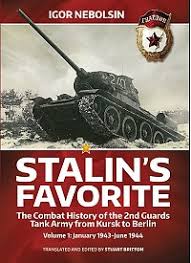
Stalin’s Favorite was a book that I was looking forward to reading and now that I am, I can honestly say it was worth the wait. It is incredibly detailed, yet unique in my experience in the English langue to read such a rich history so beautifully displayed.
Each chapter focuses on a particular combat operation ending in this volume in Romania in 1944. The chapter begins with an overview of the operation, key orders, day by day combat descriptions, the after action reviews conducted, and key combatants who received medals or recognition in that operation. There are plenty of tables listing day by day tank and personal readiness which is a treasure trove of information.
Some surprising facts in reading this book were:
1. As much as the Germans will remark upon the mud, rain, and snow, it also affected the Soviet forces equally. In both winter engagements (Jan/Feb 1943 and 1944) the weather had an adverse effect on the Army’s mobility and supply. This book goes into the inability to transport artillery shells to support the operation.
2. During the battle of Kursk the Army was deployed on the Northern Front and this clearly lays out the three options that were developed in response to possible German actions prior to the commencement of operations. Day by day action is recounted and when the 16th Tank Corps conducts a disorganized assault and has the 107th Brigade decimated the failure in this action is laid bare. However, subsequent actions are also shown as being more successful contributing to the overall Soviet success at Kursk.
3. The Sevesk Operation is interesting in differentiating first day casualties in causing a breach and an inability to follow through on the offensive. The change in German tank tactics, to engaging at 1500 – 2000 m was interesting to note.
4. Korsun, I have read the book “The Korsun Pocket” by Niklas Zetterling and while he talks about the challenges facing the German army in extracting Group Stemmermann due to the weather, he rarely utilizes Russian sources to show the impact the mud had on the mobility of the 2nd Guards Army in responding to the German push. This book is a welcomed and opposing counterpoint to this novel.
I was surprised to see the continued use of light tanks in the Army until 1944. Prior to the Korsun engagements the tank formations consist roughly 1/3 T-70 and 2/3rds T-34. The first mention of SU-85’s and JS-1’s (with the 85mm) is in the battles of the Korsun Pocket. The common perception that in 1943 the USSR had SU-85’s and in 1944 T-34/85’s is, at least from this armies perspective, false. I am aware that latter in 1944 they will receive T-34/85’s and JS-2’s and I am looking forward to reading how the army sees these tanks as an improvement. There is no doubt though, that for a period of almost a year in 43/44 the German tanks outclassed everything the USSR had.
For anyone interested in the eastern front and the Russian perspective of operations at the Brigade to Army level I would highly recommend this book, from operational summaries, to lessons learnt, and notable actions it is a wealth of information. I look forward to the second volume and the continued actions of this tank army.
-AR-
Ray,
Thank you very much for purchasing the book and the honest and interesting review of it. Highly appreciated! I hope you will enjoy Volume 2 as well which should be released soon.
LikeLike
Sir,
I am very much looking forward to volume 2 and have it pre-ordered.
Sincerely
Ray
LikeLike
Hi Ray, I wonder if you got Volume 2 of Stalin’s Favorite? I would be great to get your opinion of it.
Best Regards,
Igor Nebolsin
LikeLike
Igor,
I have a copy of the book. I was delayed in reading it due to a course I was taking however I am very much looking forward to enjoying your latest English work. I will post my notes after I have read it!
Ray
LikeLike
Hi Ray, I hope you are fine. Did you have some time to read volume 2 of Stalin’s Favorite?
LikeLike